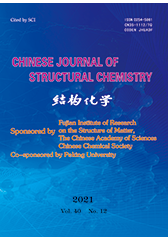Two Polyoxometalate-based Host-guest Compounds: Synthesis, Crystal Structure and Catalytic Performance
WANG Song-Xia, WANG Sa-Sa, WU Xiao-Yuan, YANG Wen-Bin and LU Can-Zhong*
Chin. J. Struct. Chem. 2021, 40, 1655-1660 DOI: 10.14102/j.cnki.0254-5861.2011-3226
December 15, 2021
polyoxometalates, catalytic oxidation, aniline, nitrosobenzene
ABSTRACT
Two
polyoxometalate-based host-guest compounds, (HL1)2(HPW12O40)·~11H2O
(1), (HL2)3(PW12O40)·3H2O
(2) (L1 = guanine, L2 = 2-(1H-1,2,4-triazol-3-yl)pyridine),
were synthesized under hydrothermal conditions and characterized by EA, PXRD,
TG, FT-IR and X-ray single-crystal diffraction. Compound 1 crystallizes in trigonal space group P-3 with a = 18.2917(5), b = 18.2917(5), c = 13.5441(5) Å, V =
3924.5(3) Å3, Z = 3, Mr = 3383.26 g/mol, ρcalc = 4.036 g/cm3, F(000) = 4137, μ = 48.532 mm–1, GOOF = 1.062, the final R = 0.0713 and wR = 0.1865 for 9037 observed
reflections with I > 2σ(I). Compound 2 crystallizes in trigonal space group R-3 with a = 19.0017(6), b = 19.0017(6), c = 25.6361(9) Å, V =
8016.2(6) Å3, Z = 6, Mr = 3372.45 g/mol, ρcalc = 4.188 g/cm, F(000) = 8886, μ = 47.644 mm–1, GOOF = 1.077, the final R = 0.0380 and wR = 0.0976 for 5904 observed
reflections with I > 2σ(I).
These two compounds can catalyze selective oxidation of aniline with H2O2 as the oxidant. Under optimal conditions, the conversion of aniline with
compound 1 can reach up to 91.25%,
and the selectivity of nitrosobenzene is 78.81%.








